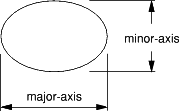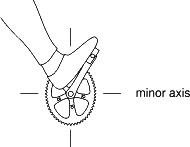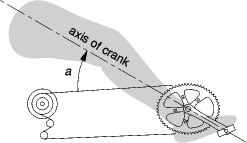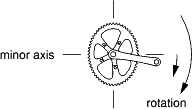
EGGring Oval Chainring Notes
page 2 - Technical Information
Home - Map - Prostate Cancer - Cycletouring - Highpath - EGGrings - Swing Crank - BROX - Cycle Tech - RISC OS

page 2 - Technical Information
A more accurate question would be 'What ovality?' since even round chainrings are oval - a circle is just an oval with 0% ovality, just like a square is a rectangle with equal sides. So, on that basis, maybe Ovals aren't so outrageous after all!
Believe it or not, but a round chainring doesn't transfer power to your rear wheel as smoothly as an Oval one.
As you pedal, the linear motion of your muscles is converted to the rotary motion of your cranks. This is similar to the pistons and crankshaft in a car engine, but such engines incorporate a flywheel to smooth out the uneveness of this conversion.
The jerky power transfer on a cycle is most apparent when you pedal up a steep hill and lurch forwards with each stab on the pedals. The more Oval your chainring is, the less pronounced this 'stop-go' effect becomes.
The graph shows how the potential to transfer power to your rear wheel varies during one complete crank revolution, for both round and Oval chainrings. Notice how the Oval curve is smoother - it has a higher minimum and a lower maximum, meaning a less jerky power transfer.

Your cycle's mechanical efficiency remains unchanged as your aerodynamics and rolling resistance are the same whichever chainring you use, but academic research suggests that Ovals can increase your own physiological efficiency by one or two percent. (But don't be fooled by the inflated figures claimed by some manufacturers - they simply aren't true!)
On the graph, notice that the Oval's maximums are wider, with less time wasted inbetween. This represents an opportunity to transfer more energy to your rear wheel. In mathematical terms, the greater area under the Oval curve equates to greater potential energy. An Oval allows you to work harder, especially when pedalling slowly, and you may be able to climb hills that defeated you before, but it is still you that has to do the work!
 This specifies how out-of-round an Oval is in percentage terms and indicates how much bigger the major-axis is than the minor-axis. Round chainrings have 0% ovality.
This specifies how out-of-round an Oval is in percentage terms and indicates how much bigger the major-axis is than the minor-axis. Round chainrings have 0% ovality.
ovality = ( major-axis - 1 ) × 100%
minor-axis
The table of ovalities has been compiled after trials on- and off-road. Road racers who spin their pedals fast can use round outer rings; at the other extreme, offroad trials demand the utmost control at low speeds and benefit from the use of very oval chainrings.
Although you should generally choose the same number of teeth as you would for round chainrings, the smallest Oval that will fit your cranks will be a few teeth larger than the smallest round ring. This is because an Oval is narrower across its minor axis and the teeth inevitably pass closer to the fixing bolts at these points. The minimum number of teeth may be estimated as follows:
smallest Oval = smallest round where V = ovality (%)
( 1 - A×V ) A = 0.004 if odd no. of fixing bolts
= 0.0025 even .. .. ..
Your crank's position relative to an Oval's axes is crucial if the lowest gear is to be provided when your feet are at the dead-spots. The exact position is determined by the geometry of your cycle and your riding position on it.

power stroke on an upright bicycle

power stroke on a recumbent
I calculate the amount your crank is offset from the minor axis from information you supply with your order, and I mark your Oval to show where your crank should be. This offset has to be a compromise if you sit on the saddle at times and stand on the pedals at others, and a different value may apply to each chainring on double and triple chainsets. If you are interested in measuring the offsets for your cycle, do so as follows:


crank advanced

crank retarded
The following table gives typical crank offsets for various styles of riding:
| type of cycling | riding on/off the saddle |
outer chainring |
middle chainring |
inner chainring |
|||
|---|---|---|---|---|---|---|---|
| road racing | on + off | 10° ret | 5° ret | - | |||
| road touring | large wheels small wheels |
on on + off on on + off |
20° ret 20° ret 5° ret 5° ret |
20° ret 15° ret 5° ret 0° |
20° ret 10° ret 5° ret 5° adv |
||
| off-road | racing touring trials |
on + off on on + off |
10° ret 15° ret 5° ret |
5° ret 15° ret 0° |
0° 15° ret 5° adv |
||
| BMX | off | 15° adv | - | - | |||
| recumbent | on | 60° ret | 60° ret | 60° ret | |||
You should normally use the same size Oval chainring as the round chainring it replaces, but it will feel different at first. An Oval feels like a larger round ring during the power-stroke and a smaller one at the dead-spots. You can calculate the sizes of these equivalent round rings as follows:

Add ovality × no. of teeth
(200 + ovality)

Subtract ovality × no. of teeth
(200 + ovality)
So, for example, a 42t chainring with 10% ovality feels like a 44t ring during the power-stroke and a 40t ring at the dead-spots ( ie. add or subtract (10/210x42) teeth ).
Don't be alarmed if your calculations give you funny sizes like 52.4 teeth!
A larger capacity front mech is required than for round rings, since it must cope with both the largest diameter of the the largest Oval and the smallest diameter of the smallest one. In the following example, the required capacity is found by subtracting 'S' for the small Oval from 'L' for the large one...

Alternately your existing mech may have sufficient excess capacity, which can be estimated from the knowledge that the chain will be raised by 2mm for each extra tooth on a chainring, or lowered by 2mm for each tooth removed from it.
Oval EGGrings do not affect your rear mech's capacity. (You might imagine that the mech would swing backwards and forwards as you rotate your cranks, but it hardly does so at all - which is why mild Ovals can be used with hub-gears and fixed-wheels without a chain tensioner.)